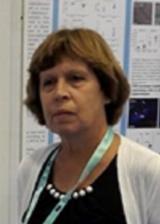Laboratory of Functional Biochemistry of the Nervous System
Main areas of research
The study of functional and biochemical mechanisms of brain plasticity. The role of apoptotic mechanisms in the functioning of the cells of the nervous system in normal and pathological conditions. The role of nitric oxide and its synthesis systems in the brain is normal and in pathology. The study of functional and biochemical mechanisms of GNI pathologies and the development of pathogenetically directed ways to correct them.
The most important results of scientific research:
1. Neurochemical mechanisms of the effects of neurotoxins as the basis of functional disorders
On the model of neurodegeneration. caused by systemic administration of kainic acid, it has been shown that convulsive activity correlates with indicators of oxidative stress, apoptosis and expression of the AP-1 transcription factor in the rat hippocampus. On the model of limbic epilepsy caused by the systemic administration of kainic acid and accompanied by neurodegeneration, the possibility of modulating the pathological effects of zinc is shown. The zinc compound reduces the degree of convulsive activity, neuronal death and the intensity of apoptosis. The phenomenon of modulation of glutamate toxicity by zinc in vivo opens up new possibilities for the correction of pathologies mediated by this mechanism.
On the model of neurodegeneration caused by the introduction of cholinotoxin AF64A into the primary neuronal cultures of the hippocampus, cortex and septum of rat embryos, it was shown that at doses of 5-80 μM AF64A causes a delayed apoptotic neurodegeneration, most pronounced after 3 days (confirmed by morphological studies, data on cell viability and "DNA laddering"). The activity of NO synthase in cells decreased with dose and time.
2. Participation of the nitrous system and proteolytic apoptotic mechanisms in neurodegeneration during ischemia.
On the model of ischemia reproduced on organotypic cultures of the hippocampus and primary cultures of cerebellar granule cells, it was shown that changes in the generation of nitrite during ischemia depend on the culture used. The effects of ischemia on the accumulation of nitrites in cultures of cerebellar granule cells were studied. An increase in nitrite accumulation as a result of 2-hour ischemia was shown to be on average 3.6 times, followed by a decrease in reoxygenation after 2 hours and restoration of the normal level after 4 hours of reoxygenation. It is assumed that the revealed changes in nitrite accumulation reflect changes in the activity of nitric oxide synthase in cerebellar cereal cells during ischemia and reoxygenation. The effects of ischemia (oxygen-glucose deprivation) and reoxygenation on the morphology of cultured rat cerebellar seed cells and the activity of caspase-3 in these cells were studied. The total proteolytic activity increases slightly immediately after ischemia, while the specific activity of caspase-3 increases by the 4th hour of reoxygenation (during this period, morphological changes in neurons indicate their destruction). It is assumed that destructive changes in cultured nerve cells subjected to ischemia and reoxygenation are associated with the activation of caspase-3 (the data were obtained in collaboration with the laboratory of experimental neurocytology of the Research Institute of the Brain of the Russian Academy of Medical Sciences).
3. The role of the nitrative system in the effects of early social deprivation
In the brain of chickens exposed to social stress, the activity of NO synthase varies depending on the type of stress and the macrostructure studied. The activity of NO synthase increased in acute separation (in the cerebellum) and chronic separation (in all studied structures). Chronic isolation did not significantly affect the activity of the enzyme.
The early social deprivation of Octodon degus causes quantitative changes in neurons containing NADPH-diaphorase in the prefronal cortex and n. accumbens. Changes in neurons containing NADPH-diaphorase were detected in the brain of 45-day-old Octodon degus after periodic separation of suckers from the mother and early (immediately after termination of sucking) social isolation. Separation caused a decrease in the number of neurons containing NADPH-diaphorase in corpus callosum. Social isolation reduced the density of NADPH-diaphorase - containing neurons in the corpus callosum, as well as in the precentral medial cortex (only in females). The results obtained can be explained by excessive reduction of neurons containing NADPH-diaphorase, or by inhibiting the activity of this enzyme as a result of early social isolation / separation and indicate a connection between the early negative socio-emotional experience and the maturation of neurons containing NADPH-diaphorase. In Octodon degu, the enzyme activity is increased in the cerebral cortex immediately after 24 days of isolation (starting at 21 days of age). The repeated separation of the Octodon degu suckers from mothers (until the 21st day) did not have a significant effect on the activity of NO synthase in the cerebral cortex of 45-day-old animals (data obtained in collaboration with the juvenile training group of the Institute of Neurobiology, Magdeburg, Germany).
Early social stress in Wistar rats causes an increase in NO-synthase activity in the brain. 6-week isolation of male rat pups from the age of 21 days leads to an increase in the activity of NO synthase in the hippocampus of rats immediately after social stress and in the hippocampus and the cerebral cortex 10 weeks after the animals return to their normal environment from isolation.
Thus, early social isolation stress in Wistar rats and the American shrub rat Octodon degu causes an increase in the activity of NO-synthase in specific brain regions. This phenomenon, detected both immediately after social stress and in the long term, seems to mediate the long-term behavioral disturbances observed in these animals.
4. Modeling Alzheimer's Disease in Rats
A study was made of the possible connection between amnesia caused by central administration of β-amyloid (25-35) [Аβ (25-35)] and neurodegenerative changes in the hippocampus. Male Wistar rats were intracerebroventricularly administered with Aβ (25-35) at a dose of 15 nmol. 1 month after the injection, the animals were trained in an eight-arm radial labyrinth. At the end of the study, a histological study of the state of the hippocampus was performed on hematoxylin / eosin stained brain sections. Аβ (25-35) caused a violation of long-term (reference) and working memory during training in the maze. A moderate decrease in the number of neurons in the CA1 field of the hippocampus was revealed; the number of cells in the CA3 field did not change. It was found that the number of errors made by animals during training in the maze, negatively correlated with the number of nerve cells in the CA1 field of the hippocampus. Thus, for the first time, it has been demonstrated that learning and memory disorders caused by a single administration of Aβ (25-35) are specifically associated with neurodegeneration in the CA1 hippocampal field in rats.
The effect of intracerebroventricular administration of Aβ (25-35) on the reproduction of the pre-learned food searching skill in an 8-arm radial maze in rats was also investigated. Aβ (25-35) was administered bilaterally at a dose of 15 and 30 nmol / animal 7 days after prior training. Testing was performed 60 days after peptide administration. It is shown that Aβ (25-35) violates the short-term working memory in rats, without having a significant impact on the preservation of the skill. Unable to identify the dependence of memory disorders on the dose of peptide. The data presented indicate the ability of Aβ (25-35) to more impair the function of working memory than long-term memory.
Intragippocampal administration of a neurotoxic beta-amyloid fragment 25-35 at a dose of 3 nmol causes neurodegeneration, accompanied by the appearance of apoptotic nuclei, activation of astroglia and caspase-3. Tumor necrosis factor alpha, administered intracerebroventricularly at a dose of 0.5 µg, does not cause neurodegeneration, activation of astroglia and caspase-3, however, it increases neurodegeneration and activation of astroglia caused by a fragment of beta-amyloid without additional amplification of apoptosis and activation of caspase in the hippocampus. It is assumed that the enhancement of tumor necrosis factor alpha neurodegeneration processes caused by beta-amyloid fragment 25-35, is not associated with activation of apoptosis.
Preliminary results were obtained on the effects of tumor necrosis factor alpha on the behavior of rats. This cytokine does not interfere with the training of rats in the 8-arm radial maze, but it has a significant effect on the behavior in the passive avoidance test.
5. Study of the molecular mechanisms of neurodegeneration in the simulation of seizure activity.
The administration of pentyleneterazole to mice at a dose of 85 mg / kg subcutaneously causes inhibition of caspase-3 activity in the brain regions of animals. This effect of pentylenetetrazole may be associated with the development of oxidative stress in brain tissue, since, as we have shown earlier, in vitro modeling of oxidative stress by adding hydrogen peroxide dose-dependently inhibits caspase-3 activity in PC12 neuron-like cells.
Convulsive readiness caused by chronic administration of subliminal doses of a convulsant (pentylenetetrazol kindling) is accompanied by changes in the plasticity of the brain, expressed in functional (impaired learning) and structural (neurodegeneration in specific areas of the hippocampus) rearrangements. Changes in neuroplasticity are mediated by the development of oxidative stress and the activation of caspase-3 in the hippocampus.
Convulsive readiness caused by chronic administration of subliminal doses of the convulsant pentylenetetrazole (pentylenetetrazol kindling) is accompanied by changes in brain plasticity, manifested in functional (learning disruption) and structural (neurodegeneration in specific areas of the hippocampus) rearrangements. It is assumed that changes in neuroplasticity are mediated by the development of oxidative stress and activation of caspase-3 in the hippocampus. With pentylenetetrazol kindling, correlation dependences were found between the degree of neurodegeneration in the fields of the hippocampus CA1 and CA3, as well as in the dentate fascia and the severity of convulsive activity. Impaired development of active avoidance reactions also correlated with severity of convulsive activity, and neurodegeneration in the CA3 field of the hippocampus. Thus, on the model of pentylenetetrazol kindling, quantitative data were obtained for the experimental confirmation of the link between seizure activity, neurodegeneration in the hippocampus and the ability of animals to learn.
The relationship between seizure activity caused by repetitive electroshock (ES) and structural changes in the hippocampus of Balb / C mice was studied. After 2 and 7 days after completion of the EL, the brain of the animals was fixed and sections were stained according to Nissl and immunohistochemically for apoptotic nuclei (TUNEL). Additionally, the activity of the key enzyme apoptosis of caspase-3 was measured immediately in the brain regions immediately after the end of ES. The number of neurons was significantly reduced in the CA1 field and the dentate fascia, but not in the CA3 field of the hippocampus. The number of cells in CA1 and CA3 inversely correlated with the intensity of seizures. No signs of apoptotic neuronal death were detected, and caspase-3 activity was significantly reduced in the hippocampus after EL. The presented data confirm the idea of functional changes in neurons after EL and deepen this idea, directly indicating a moderate (within 10%), but reliable neuron death in certain areas of the hippocampus. The inverse correlations of the number of cells with the degree of convulsive activity suggest that the main cause of neuron death is convulsions caused by EL.
6. Stroke modeling and assessment of animal neurological status.
A new method for assessing the functional state of rats after brain ischemia according to the animal's ability to pull the tongue is proposed. The results obtained using this method on the model of focal ischemia caused by occlusion of the middle cerebral artery, significantly correlate with data from other tests for neurological deficit and the size of brain infarction. The method is extremely simple and can be used as a component in a battery of tests when assessing post-ischemic functional impairments or independently when screening neuroprotective drugs and effects.
7. Development and confirmation of the hypothesis about the role of caspase-3 in the mechanisms of neuroplasticity, not associated with the death of nerve cells.
Under conditions of tumor necrosis factor-induced alpha apoptosis or phorbol-12-myristate-13-acetate-induced differentiation in cultured U-937 cells, similar activation of Ca2 + / Mg2 + -dependent nuclease was found, accompanied by activation of caspase-3 and the appearance of nucleosomal DNA fragments. The data obtained indicate that chromatin fragmentation in apoptotic and differentiating cells is carried out by the same enzymes of the apoptotic cascade (data obtained in collaboration with the Laboratory of Cell Engineering at the Institute of Theoretical and Experimental Biophysics, RAS).
In cultures of neuron-like cells PC12, apoptosis caused by hydrogen peroxide has not been shown to be accompanied by activation of caspase-3 or caspase-1. In vitro experiments have shown that caspase-3 activity in PC12 cells is dose-dependently reduced in the presence of hydrogen peroxide.
It was established that caspase-3 activity in the gopher brain naturally changes during the hibernation cycle. In the majority of the studied parts of the brain, the maximum activity is observed during the hibernation or hibernation period. Since apoptotic neuronal death in the gopher brain during the hibernation period is not described, caspase is assumed to perform a non-apoptotic function associated with plastic rearrangements of brain cells during hibernation.
Inhibition of caspase-3, a key enzyme in the apoptotic neuronal death, has been shown to block the development of NMDA-dependent long-term potentiation in rat hippocampal slices and a long-term increase in HPSP in the identified cochlear neurons during tetanization against serotonin, and also disrupts the training of active avoidance in rats. The results obtained allow us to postulate a new mechanism for the realization of the phenomena of neuroplasticity, common for vertebrates and invertebrates, including limited proteolysis of specific substrates, and suggest that caspase-3 plays a pleiotropic role in the nervous system. (represented by laboratories of functional biochemistry of the nervous system, neuroontogenesis, cellular neurobiology of learning).
Based on the results obtained, a hypothesis was formulated about the role of caspase-3 in the mechanisms of neuroplasticity that are not associated with the death of nerve cells.
Scientific experimental base. Basic methods
The laboratory is located at Leninsky Prospect, 33, box. 1. There are premises for experimental studies, isotopic block and vivarium.
The laboratory has:
- equipment for behavioral research (installations for the study of active and passive avoidance, 8-arm and Y-shaped mazes),
- installations for creating stress situations
- installation for simulation of convulsive activity with maximum electroshock,
- equipped workplaces to simulate stroke in mice and rats (occlusion of four arteries and occlusion of the middle cerebral artery),
- stereotactic systems for the implementation of injection models of neurodegeneration,
- equipment for pathological and immunohistochemical experiments,
- equipment for conducting biochemical studies (optical instruments, centrifuges, equipped isotopic unit) allows, in the presence of appropriate reagents, to conduct a wide range of biochemical studies,
western blot equipment - equipment for the study of the binding of receptors with ligands.
On the existing equipment, complex studies of the behavior and neurochemical mechanisms of learning and memory are carried out in normal and pathological conditions, in particular, in modeling the neurodegeneration of various geens.
Books
- Gulyaeva NV, Stepanichev MYu. Biochemical correlates of individual behavior. In: Complex Brain Functions: Conceptual Advances in Russian Neuroscience. Eds. Miller R, Ivanitsky AM, Balaban PM. Australia et al., Harwood Academic Publ., 1999. P. 301-316.
Список сотрудников
Publication list
Papers
- Trubetskaya V.V., Stepanichev M.Y., Onufriev M.V., Lazareva N.A., Markevich V.A., Gulyaeva N.V. Administration of aggregated beta-amyloid peptide (25-35) induces changes in long-term potentiation in hippocampus in vivo. Zhurnal Vysshei Nervnoi Deiatelnosti im I P Pavlova. 2001. V. 51. N. 6. P. 701-704.
- Trubetskaya V.V., Stepanichev M.Y., Onufriev M.V., Lazareva N.A., Markevich V.A., Gulyaeva N.V. Increased NO synthase activity in rat hippocampus accompanies prolonged in vivo potentiation. Nejrokhimija. 2001. V. 18. P. 55-61.
- Tsubetskaya V.V., Stepanichev M.Y., Onufriev M.V., Lazareva N.A., Markevich V.A., Gulyaeva N.V. Administration of aggregated beta-amyloid peptide (25–35) induces changes in long-term potentiation in the hippocampus in vivo. Zhurnal Vysshei Nervnoi Deiatelnosti im I P Pavlova. 2001. V. 51. P. 701-704.
- Yakovlev A.A., Onufriev M.V., Stepanichev M.Y., Braun K.., Gulyaeva N.V. Caspase-3 activity in different parts of the brain of rodents. Nejrokhimija. 2001. V. 18. P. 41-43.
- Yakovlev A.A., Onufriev M.V., Stepanichev M.Y., Gulyaeva N.V. The effect of pentylenetetrazole on caspase-3 activity in the brain regions of mice. Nejrokhimija. 2001. V. 18. P. 191-194.
- Kudryashov I.E., Onufriev M.V., Kudryashova I.V., Gulyaeva N.V. Periods of postnatal maturation of hippocampus: Synaptic modifications and neuronal disconnection. Developmental Brain Research. 2001. V. 132. N. 2. P. 113-120. DOI: 10.1016/S0165-3806(01)00301-7
- Melnik V.I., Bikbulatova L.S., Gulyaeva N.V., Bazyan A.S. Synaptic vesicle acidification and exocytosis studied with acridine orange fluorescence in rat brain synaptosomes. Neurochemical Research. 2001. V. 26. N. 5. P. 549-554. DOI: 10.1023/A:1010973214930
- Bikbulatova L.S., Melnik V.I., Gulyaeva N.V., Bazyan A.S. Acridinorange as a fluorescent probe for the study of acidification and exocytosis of synaptic vesicles in synaptosomes. Nejrokhimija. 2000. V. 17. P. 303-308.
- Novikova M.R., Sharova E.V., Mikheeva T.S., Shishkina L.V., Kulikov M.A. The effects of combined electrolytic brain stem-orbitofrontal and brain stem-hippocampal damages to the rat brain. Patologicheskaya Fiziologiya i Eksperimentalnaya Terapiya. 2000. V. 1. N. 3. P. 5-9.
- Sarkisova K.Y., Kulikov M.A. Profilactic effect of antioxidant AEKOL on behavioral (psychoemotional) disturbances caused by chronic stress in rats. Rossijskij Fiziologicheskij Zhurnal im I M Sechenova. 2000. V. 86. N. 5. P. 557-564.
- Sarkisova K.Y., Kulikov M.A. Wag/Rij rats: new genetically determined model of animal depression?. Doklady Academii Nauk. 2000. V. 374. N. 6. P. 732-775.
- Khaspekov L.G., Onufriev M.V., Viktorov I.V., Gulyaeva N.V. The effect of ischemia and reoxygenation on the accumulation of nitrites in rat cerebellum grain cell cultures. Nejrokhimija. 2000. V. 17. P. 267-270.
- Sharova E.V., Novikova M.R., Mikheeva T.S., Shishkina L.V., Kulikov M.A. The effects of combined electrolytic stem-orbitofrontal and stem-hippocampal damage to rat brain. Patologicheskaja Fiziologija i Eksperimentalnaja Terapija. 2000. V. ??. N. 3. P. 5-9.
- Bobrysheva I.V., Chernyavskaya L.I., Onufriev M.V., Grivennikov I.A., Gulyaeva N.V. Hydrogen peroxide dose-dependently inhibits caspase-3 in PC12 cells. Nejrokhimija. 2000. V. 17. P. 93-98.
- Lautenschlager M., Onufriev M.V., Gulyaeva N.V., Harms C., Freyer D., Sehmsdorf U.-., Ruscher K., Moiseeva Y.V., Arnswald A., Victorov I., Dirnagl U., Weber J.R., Hortnagl H. Role of nitric oxide in the ethylcholine aziridinium model of delayed apoptotic neurodegeneration in vivo and in vitro. Neuroscience. 2000. V. 97. N. 2. P. 383-393. DOI: 10.1016/S0306-4522(99)00599-0
- Lautenschlager M., Onufriev M.V., Gulyaeva N.V., Harms C., Freyer D., Sehmsdorf U.-., Ruscher K., Moiseeva Y.V., Arnswald A., Victorov I., Dirnagl U., Weber J.R., Hortnagl H. Role of nitric oxide in the ethylcholine aziridinium model of delayed apoptotic neurodegeneration in vivo and in vitro. Neuroscience. 2000. V. 97. N. 2. P. 383-393. DOI: 10.1016/S0306-4522(99)00599-0
- Onufriev M.V., Terenina N.B., Lindholm A.M., Reuter M., Gustafsson M.K., Gulyaeva N.V. Neuronal form of nitric oxide synthase activity in Hymenolepis diminuta (Cestoda: Pseudophyllidae). Nejrokhimija. 2000. V. 17. P. 37-41.
- Poeggel G., Haase C., Gulyaeva N.V., Braun K. Quantitative changes in reduced nicotinamide adenine dinucleotide phosphate-diaphorase-reactive neurons in the brain of Octodon degus after periodic maternal separation and early social isolation. Neuroscience. 2000. V. 99. N. 2. P. 381-387. DOI: 10.1016/S0306-4522(00)00190-1
- Stepanichev M.Y., Onufriev M.V., Bock J., Gulyaeva N.V., Poeggel G., Braun K. Changes of nitric oxide synthase activity in response to different levels of social separation in two day old domestic chicks (Gallus gallus domesticus). Neuroscience Research Communications. 2000. V. 27. P. 175-181.
- Stepanichev M.Y., Onufriev M.V., Mitrokhina O.S., Moiseeva Y.V., Lazareva N.A., Victorov I.V., Gulyaeva N.V. Neurochemical, behavioral, and neuromorphological effects of central administration of beta-amyloid peptide (25-35) in rat. Nejrokhimija. 2000. V. 17. P. 278-290.
- Stepanichev M.Y., Zdobnova I.M., Zarubenko I.I., Lazareva N.A., Onufriev M.V., Moiseeva Y.V., Chernyavskaya L.I., Gulyaeva N.V. Seizure intensity correlates with oxidative stress and apoptosis in the hippocampus in the kainic acid model in rat. Nejrokhimija. 2000. V. 17. P. 189-191.
- Terenina N.B., Onufriev M.V., Gulyaeva N.V., Lindholm A.M., Gustafsson M.K. A radiometric analysis of nitric oxide synthase activity in Hymenolepis diminuta. Parasitology. 2000. V. 120. N. 1. P. 91-95. DOI: 10.1017/S0031182099005284
- Gulyaeva N.V., Brusovanik V.I., Lazareva N.A., Libe M.L., Mikhalev S.L., Onufriev M.V., Chernyavskaja L.I. Indices of free radical oxidation in plasma of umbilical cord blood and placenta of residents of Altai Territory. Izvestija Academii nauk, serija biologicheskaja. 1999. V. 1. N. 4. P. 453-457.
- Kudryashova I.E., Kudryashova I.V., Sitnikova E.Y., Raevsky V.V. The effect of forelimb deafferentation in early postnatal ontogeny on the development of synaptic transmission in the hippocampus. Zhurnal Vysshei Nervnoi Deiatelnosti im I P Pavlova. 1999. V. 49. N. 4. P. 554-565.
- Kudryashov I.E., Kudryashova I.V., Sitnikova E.Y., Raevsky V.V. The influence of deafferentation of the forelimb in early postnatal ontogenesis on the formation of synaptic transmission in the hippocampus. Zhurnal Vysshei Nervnoi Deiatelnosti im I P Pavlova. 1999. V. 49. N. 4. P. 629-634.
- Mitrokhina O.S., Stepanichev M.Y., Lazareva N.A., Moiseeva Y.V., Onufriev M.V., Gulyaeva N.V. The effect of intracerebroventricular administration of a fragment (25-35) of beta-amyloid peptide on lipid peroxidation in rat brain and blood. Doklady Akademii Nauk. 1999. V. 368. P. 711-713.
- Moiseeva Y.V., Egorova L.K., Onufriev M.V., Mitrokhina O.S., Lazareva N.A., Stepanichev M.Y., Gulyaeva N.V. NO synthase activity and indicators of free radical oxidation in the brain regions of Wistar rats resistant and prone to audiogenic epilepsy: effects of immobilization stress. Nejrokhimija. 1999. V. 16. P. 54-61.
- Onufriev M.V., Stepanichev M.Y., Mitrokhina O.S., Moiseeva Y.V., Lazareva N.A., Gulyaeva N.V. The effect of oxidative stress on the activity of nitric oxide synthase in vivo and in vitro. Rossijskoj Fiziologicheskij Zhurnal. 1999. V. 85. P. 531-538.
- Rozhnova U.A., Stepanichev M.Y., Korobko V.G., Gulyaeva N.V., Alesenko A.V. Activation of the sphingomoelin cycle and cholesterol accumulation in rat cortex, hippocampus and cerebellum under the action of tumor necrosis factor alpha. Nejrokhimija. 1999. V. 16. 118-131.
- Stepanichev M.Y., Onufriev M.V., Lazareva N.A., Zarzhetsky Y.V., Mutuskina E.A., Gurvich A.M., Gulyaeva N.V. Delayed effects of systemic circulatory arrest on free radical processes in the brain structures of rats with different types of behavior in the emotional resonance test. Zhurnal Vysshei Nervnoi Deiatelnosti im I P Pavlova. 1999. V. 49. P. 653-663.
- Poeggel G., Lange E., Hase C., Metzger M., Gulyaeva N.V., Braun K. Maternal separation and early social deprivation in octodon degus: Quantitative changes of nicotinamide adenine dinucleotide phosphate-diaphorase-reactive neurons in the prefrontal cortex and nucleus accumbens. Neuroscience. 1999. V. 94. N. 2. P. 497-504. DOI: 10.1016/S0306-4522(99)00289-4
- Rakusan K., Ehrenburg I.V., Gulyaeva N.V., Tkatchouk E.N. The effect of intermittent normobaric hypoxia on vascularization of human myometrium. Microvascular Research. 1999. V. 58. N. 2. P. 200-203. DOI: 10.1006/mvre.1999.2180
- Silkis I.G., Egorova L.K., Markevich V.A., Gulyaeva N.V. On the participation of GABAb receptors in the formation of cGMP in the cerebellar cortex. Nejrokhimija. 1998. V. 15. N. 4. P. 335-400.
- Kudryashov I.E., Kudryashova I.V., Raevsky V.V. Ribonuclease improves the state of hippocampal sections in the post-ischemic period. Neuroscience and Behavioral Physiology. 1998. V. 28. N. 4. P. 357-365. DOI: 10.1007/BF02464788
- Stepanichev M.Y., Lazareva N.A., Onufriev M.V., Mitrokhina O.S., Moiseeva Y.V., Gulyaeva N.V. Effects of doses of fragment (25-35) of β-amyloid peptide on behavior in rats. Neuroscience and Behavioral Physiology. 1998. V. 28. N. 5. P. 564-566. DOI: 10.1007/BF02463018
- Kudryashov I.E., Kudryashova I.V., Raevsky V.V. Ribonuclease improves the function of hippocampal slices in the postischemic period. Zhurnal Vysshei Nervnoi Deiatelnosti im I P Pavlova. 1997. V. 47. N. 1. P. 136-146.
- Raevsky V.V., Alexandrov L.I., Vorobieva A.D., Korneeva E.V., Kudryashov I.E., Kudryashova I.V., Pigareva M.L., Sitnikova E.Y., Stashkevich I.S. Sensory information is an important factor in ontogenesis. Zhurnal Vysshei Nervnoi Deiatelnosti im I P Pavlova. 1997. V. 47. N. 2. P. 299-307.
- Gulyaeva N.V., Stepanichev M.Y. Biochemical correlates of individual behavior. Neuroscience and Behavioral Physiology. 1997. V. 27. N. 4. P. 462-469. DOI: 10.1007/BF02462948
- Gurvitch A.M., Mutuskina E.A., Zarzhetsky Y.V., Trubina I.E., Avruschenko M.S., Pylova S.I., Volkov A.V., Lazareva N.A., Stepanichev M.Y., Onufriev M.V., Gulyaeva N.V. Prophylaxis of encephalopathies and risk factors of atherogenesis development in the postresuscitation period in rats by means of succinic acid. Resuscitation. 1997. V. 35. N. 2. P. 165-170. DOI: 10.1016/S0300-9572(97)00045-2
- Stepanichev M.Y., Onufriev M.V., Lazareva N.A., Zazhetsky Y.V., Mutuskina E.A., Gutvitch A.M., Gulyaeva N.V. Postresuscitation changes in brain free radical-mediated processes and nitric oxide synthase activity in rats: effects of individual behavior in "emotional resonance" test. Neurochemical Research. 1997. V. 22. N. 6. P. 743-752.
- Sharova E.V., Novikova M.R., Mikheeva G.S., Shishkina L.V., Lushchekina E.A. Local destruction of Deiters' lateral vestibular nucleus (an experimental model of a focal brain stem lesion). Zhurnal Vysshei Nervnoi Deiatelnosti im I P Pavlova. 1996. V. 46. N. 3. P. 583-591.
- Gulyaeva N.V., Lazareva N.A., Libe M.L., Mitrokhina O.S., Onufriev M.V., Stepanichev M.Y., Chernysevskaya I.A., Walsh T.J. Oxidative stress in the brain following intraventricular administration of ethylcholine aziridinium (AF64A). Brain Research. 1996. V. 726. N. 1-2. P. 174-180. DOI: 10.1016/0006-8993(96)00330-7
- Gulyaeva N.V., Stepanichev M.Y., Onufriev M.V., Lazareva N.A., Zarzhetsky Y.V., Gurvitch A.M., Volkov A.V. Cardiac arrest induces decrease of nitric oxide synthase activity and increase of free radical generation in rat brain regions. Neuroscience Letters. 1996. V. 220. N. 3. P. 147-150. DOI: 10.1016/S0304-3940(96)13250-X
- Balaban P.M., Bravarenko N.I., Voronin L.L., Gusev P.V. Long-term potentiation in the helix central nervous system after intracellular tetanization. Doklady Academii Nauk. 1995. V. 343. N. 4. P. 563-566.
- Bravarenko N.I., Gusev P.V., Balaban P.M., Voronin L.L. Postsynaptic induction of long-term synaptic facilitation in snail central neurons. NeuroReport. 1995. V. 6. N. 8. P. 1182-1186. DOI: 10.1097/00001756-199505300-00027
- Gulyaeva N.V., Onufriev M.V., Stepanichev M.Y. No synthase and free radical generation in brain regions of old rats: Correlations with individual behaviour. NeuroReport. 1994. V. 6. N. 1. P. 94-96. DOI: 10.1097/00001756-199412300-00025













